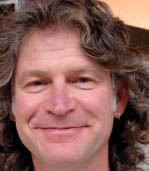UO Physics Prof. Richard Taylor’s Winning Idea

Cottrell Scholar and Scialog Fellow Richard Taylor, professor of physics at the University of Oregon, beat out hundreds of competitors to take the No. 1 spot in a recent challenge to identify revolutionary platform technologies for advancing life sciences research.
He accepted his award in late April at a White House Office of Science and Technology Policy (OSTP) ceremony.
The “ideation” competition, conducted by the innovation company InnoCentive, was sponsored by a collaboration of science philanthropies including Research Corporation for Science Advancement (RCSA), the Gordon and Betty Moore Foundation, the W.M. Keck Foundation, the Kavli Foundation, the Templeton Foundation, and the Burroughs Wellcome Fund.
Taylor’s winning proposal deals with the development of artificial human implants using “interconnects” that mimic the biological circuitry employed by the body. Director of the UO Materials Science Institute, Taylor conducts research focused on natural branching patterns known as fractals in physics, psychology, physiology, geography, architecture and art. Some of his previous work is funded by RCSA.
Taylor’s idea for revolutionary platform technology focuses on the use of fractal microelectronic retinal prostheses for treating blindness in human patients.
“Imagine a world in which damaged parts of the body – an arm, or an eye, or even a region of the brain – can be replaced by artificial implants capable of restoring or even enhancing human performance,” Taylor wrote in his proposal.
Besides science philanthropy representatives, officials from the Defense Advanced Research Projects Agency (DARPA), the National Institutes of Health, the National Science Foundation, the U.S. Department of Agriculture and the Department of Defense were also present at the ceremony.
Taylor gave a five-minute presentation on his winning idea. The meeting also included a general discussion about how to promote a better funding at the interface between the physical and life sciences.
The science philanthropies chose InnoCentive to conduct the competition, since it is a global leader in crowdsourcing innovative problems to the world’s smartest people.
1960 Early Career Scientists: The Case for Support 4
Today, RCSA has three programs that fund early career scientists:
Since its founding in 1912, Research Corporation for Science Advancement (RCSA) has been a catalyst for transformative research in science and science education. It has focused heavily on supporting high-risk high-reward science and, in doing so, has been a consistent funder of early career scientists, with whom ground-breaking research is frequently associated.
Early career scientists are typically those within the first 10 years of their academic careers – generally pre-tenure and assistant professors. It is a fact that in most fields of human endeavor well-educated, bright, young people simply have the most innovative ideas. They are less constrained by well established paradigms and preconceived notions, and they are eager to establish themselves. They also tend to be enthusiastic, highly effective teachers.
Early career scientists are also eager to create their own labs and develop a funding stream for their research. Even a $25,000 grant can have a significant impact as it establishes their credibility, encourages their career ambitions and helps start their labs. As RCSA’s founder, the inventor Frederick Gardner Cottrell, advised: “Bet on the youngsters. They are long shots, but some of them pay off.” And many of them have.
In total, 40 eventual Nobel Prize-winners have received early career research funding from RCSA, including E.O. Lawrence (for whom the Lawrence Berkeley and Lawrence Livermore National Laboratories are named), Thomas Cech (former President of the Howard Hughes Medical Institute), and Carl Wieman, who served for President Barack Obama as Associate Director for Science at the U.S. Office of Science and Technology Policy.
Others, too, have gone on to great distinction. University of Arizona Professor Roger Angel, astronomy, is a 1996 MacArthur “genius grant” recipient. Dr. Angel received two RCSA grants within four years of receiving his doctorate. He subsequently founded and still runs the University of Arizona’s Steward Observatory Mirror Lab and in 2010 won the coveted Kavli Prize in astrophysics. The Lab’s pioneering work began literally with a backyard experiment by Dr. Angel 30 years ago. He and the Lab have gone on to cast 6.5-meter mirrors for the Multi-Mirror Telescope and the two Magellan Telescopes, plus two 8.4-meter mirrors for the Large Binocular Telescope – a transformative instrument supported by RCSA funding as well.
He has also received funds through RCSA’s Scialog program to aid in the development of his innovative, low cost solar concentrator system for generating photovoltaic power. In November 2012, the U.S. Department of Energy, through its SunShot Initiative, invested $1 million to commercialize the project. The SunShot money will be doled out to REhnu Inc., a company Angel co-founded, as it meets certain goals to mass-produce the concentrator systems.






